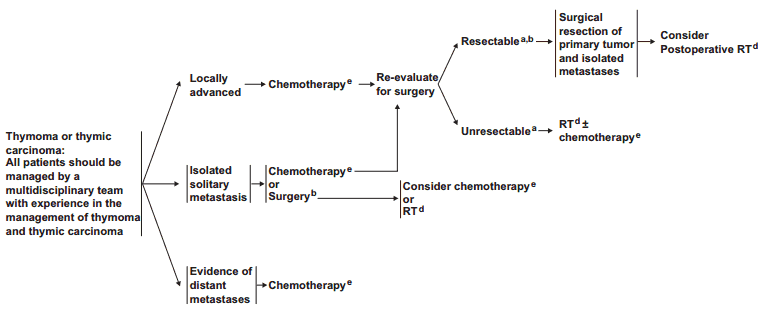Thymoma medical therapy
Medi
|
Thymoma Microchapters |
|
Diagnosis |
|---|
|
Case Studies |
|
Thymoma medical therapy On the Web |
|
American Roentgen Ray Society Images of Thymoma medical therapy |
|
Risk calculators and risk factors for Thymoma medical therapy |
Editor-In-Chief: C. Michael Gibson, M.S., M.D. [1] Associate Editor(s)-in-Chief: Amr Marawan, M.D. [2]
Please help WikiDoc by adding more content here. It's easy! Click here to learn about editing.
Overview
Surgery is the main stay of therapy. Chemo and radio therapy are used as adjuvant ot neoadjuvant therapies. Sometimes they are used prior to surgery to make the tumor resectable. Signs and symptoms of myasthenia gravis should be evaluated before surgery and medically controlled.
Medical Therapy
 |
Radiotherapy
Radiotherapy is used in unresectable thymoma or incompletely resected invasive thymoma. The dose and fractionation schemes of RT depend on the indication of the radiation and the completeness of surgical resection.[2]
Chemotherapy
It is used in locally advanced thymomas then re-evaluated for resectability. In cases of isolated solitary metastasis, we either start with chemotherapy then re-evaluate for surgery or start by surgery. It is also used if there is evidence of distant metastasis. Most of the chemotherapy being designed is based on cisplatin and anthracyclines.
Corticosteroids
Corticosteroids may be used in unresectable tumors that have been refractory to radiation therapy leading to transient partial responses.[3] Similar to the effects of ageing and stress, steroids increase thymic fat and connective tissue and decrease corticomedullar differentiation. Therefore in WHO subtypes A and B thymoma, corticosteroids produce tumour size reduction due to lymphocyte depletion.[4]
References
- ↑ "https://www.nccn.org/store/login/login.aspx?ReturnURL=http://www.nccn.org/professionals/physician_gls/pdf/thymic.pdf" (PDF). External link in
|title=(help) - ↑ "https://www.nccn.org/store/login/login.aspx?ReturnURL=http://www.nccn.org/professionals/physician_gls/pdf/thymic.pdf" (PDF). External link in
|title=(help) - ↑ "http://www.cancernet.nci.nih.gov/cancertopics/types/thymoma". External link in
|title=(help) - ↑ "Octreotide alone or with prednisone in patients... [J Clin Oncol. 2004] - PubMed - NCBI".